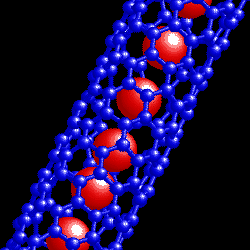A Hydrogen Filter from Nanotubes

Physicists may have found a new use for carbon nanotubes, rolled-up sheets of graphite only a few angstroms in diameter. According to a report in the 1 February PRL, a bundle of nanotubes could be used as a “quantum sieve” capable of separating two different isotopes of hydrogen. Though the technique has only been tested in computer simulations so far, it could provide a new way to filter out radioactive “heavy water” molecules produced in the cooling tanks where spent nuclear fuel rods are stored.
Carbon filters have been used for many years–in gas masks and cigarettes, for example–to separate molecules of different types, based either on size or on their chemical affinity for carbon. However, a molecular filter cannot separate ordinary hydrogen molecules from tritium, a hydrogen isotope with two extra neutrons in its nucleus, because they have the same size and chemical properties.
A nanotube filter, explains Karl Johnson of the University of Pittsburgh, would work completely differently, using the Heisenberg uncertainty principle. “The uncertainty principle says that if you know the location of a particle, its momentum is uncertain,” Johnson explains. “It hates to be confined, so it bounces around harder” the more it is confined. Hydrogen and tritium molecules can fit into a carbon nanotube, but it’s a tight squeeze. If a hydrogren molecule could be placed inside the nanotube, it would vibrate so much that it would wiggle right out of the tube. A tritium molecule also obeys the uncertainty principle, but because it is heavier it doesn’t vibrate quite as much, and is easier to trap. So if many nanotubes are put together and exposed to a mixture of hydrogen and tritium gas, they will selectively adsorb more of the tritium–at least 13,000 times more, according to Johnson’s computer calculations.
Although the quantum sieve was first proposed in 1995 by J. J. M. Beenakker of Leiden University in the Netherlands, Johnson says Beenakker’s work contained a mathematical error and oversimplified the conditions and the interactions between molecules. Johnson and his colleagues calculated the quantum sieve’s performance under more realistic conditions than the zero temperature and pressure of Beenakker’s calculation. The new simulation assumed a temperature of 20 K and a pressure of a few thousandths of a Torr. Turning up the pressure, Johnson was surprised to discover, improved the sieve’s selectivity for tritium over hydrogen.
According to other researchers, the main obstacle to making the quantum sieve idea work is fabricating nanotubes with sufficient uniformity. Peter Monson, of the University of Massachusetts in Amherst, says Johnson’s calculations assume that all of the nanotubes in the sieve are rolled up exactly the same way–a feat that materials scientists have not yet been able to pull off. “The way they’re constructed leads to different tube radii,” says Milton Cole, of Pennsylvania State University. “There’s no way I know to produce a unique species.” But, says Cole, as the technology advances, there is a good chance that quantum sieves will move off the drawing board and into the lab.
–Dana Mackenzie
Dana Mackenzie is a freelance science writer.


